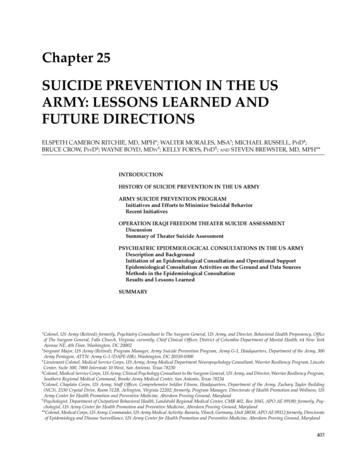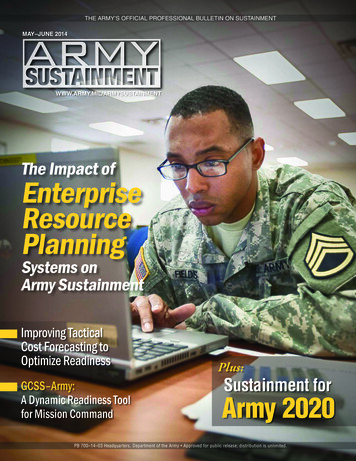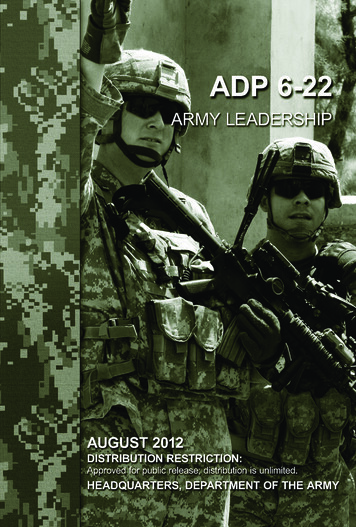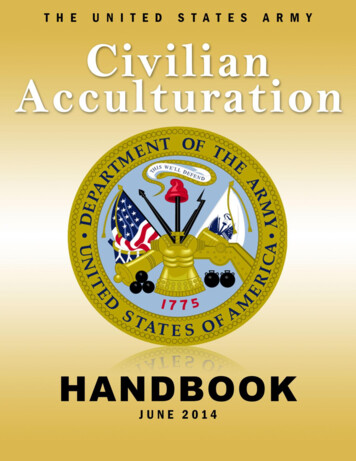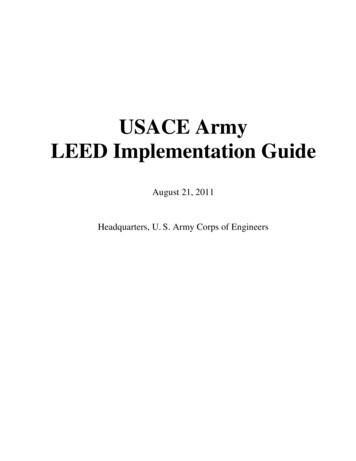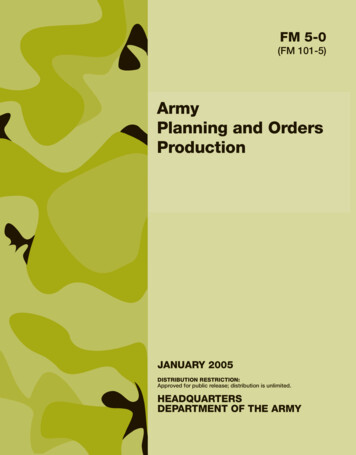
Transcription
FM 5-0(FM 101-5)ArmyPlanning and OrdersProductionJANUARY 2005DISTRIBUTION RESTRICTION:Approved for public release; distribution is unlimited.HEADQUARTERSDEPARTMENT OF THE ARMY
This publication is available atArmy Knowledge Onlinewww.us.army.mil
*FM 5-0Field ManualNo. 5-0HeadquartersDepartment of the ArmyWashington, DC, 20 January 2005Army Planning and Orders ProductionContentsPagePREFACE . vINTRODUCTION. viiChapter 1FUNDAMENTALS OF PLANNING . 1-1The Nature of Planning . 1-1Key Planning Concepts. 1-15Digital Enhancements to Planning . 1-27Effective Planning .1-28Chapter 2ARMY PROBLEM SOLVING . 2-1Problem Solving and Decision Making . 2-1Solving Problems in a Group Setting .2-4Structure of Problems . 2-5Solving Problems . 2-5Chapter 3THE MILITARY DECISION MAKING PROCESS . 3-1Background . 3-1Performing the Military Decision Making Process. 3-11Planning in a Time-Constrained Environment .3-57Chapter 4TROOP LEADING PROCEDURES . 4-1Troop Leading Procedures and the Military Decision Making Process . 4-1Performing Troop Leading Procedures. 4-4Appendix ASTAFF STUDIES AND DECISION PAPERS . A-1Staff Studies .A-1Decision Papers .A-7Distribution Restriction: Approved for public release; distribution is unlimited.*This publication supersedes the planning portion of FM 101-5, 31 May 1997.i
FM 5-0Appendix BMILITARY BRIEFINGS.B-1Types of Briefings . B-1Briefing Steps . B-4Appendix CSTAFF GUIDELINES FOR MISSION ANALYSIS.C-1Appendix DCOMMANDER’S GUIDANCE GUIDELINES .D-1Appendix EESTIMATES . E-1Appendix FTASK ORGANIZATION . F-1Fundamental Considerations. F-1Command and Support Relationships. F-3Task Organization Formats . F-7Appendix GPLANS AND ORDERS.G-1Characteristics .G-1Types of Plans .G-3Types of Orders .G-4Techniques for Issuing Orders .G-7Administrative Instructions for Preparing Plans and Orders.G-8Attachments (Annexes, Appendixes, Tabs, and Enclosures) .G-12Standing Operating Procedures .G-13Matrices and Templates .G-14Examples and Procedures for Completing Plans, Orders, and Annexes.G-16List of Figures .G-17Appendix HINTEGRATING TARGETING INTO THE OPERATIONS PROCESS.H-1Targeting Process and Targeting Team .H-1Decide.H-2Detect .H-6Deliver.H-7Assess .H-7Appendix IJOINT PLANNING . I-1Joint Planning Overview . I-1Joint Planning Concepts. I-2Joint Operation Plan Format. I-4ii
ContentsGLOSSARY .Glossary-1BIBLIOGRAPHY . Bibliography-1INDEX . Index-1iii
FM 5-0This page is left intentionally blank.iv
PrefaceDoctrine provides a military organization with unity of effort and a commonphilosophy, language, and purpose. FM 5-0 is the Army’s keystone manual forplanning operations. It is the Army’s doctrinal source for problem solving, themilitary decision making process (MDMP), troop leading procedures (TLP), andformats for Army plans and orders.PURPOSEFM 5-0 promotes a common understanding of the fundamentals of planning andprovides the foundation for developing tactics, techniques, and procedures (TTP)for planning in all Army publications. It provides a doctrinal approach to decisionmaking that helps commanders and their staffs examine a situation, reachlogical conclusions, and make informed decisions. FM 5-0 is the commonreference for planning within the Army education system.SCOPEFM 5-0 includes MDMP and formats for plans, orders, and briefings formerlyfound in FM 101-5. Staff responsibilities, staff officer duties during preparationfor and execution of operations, rehearsals, information management, and liaisonduties formerly addressed in FM 101-5, are now covered in FM 6-0.Chapter 1 describes the Army’s approach to planning and discusses the nature ofplans and planning activities. Chapter 2 discusses Army problem solving ingeneral terms and prescribes the steps of the Army problem solving process.Chapter 3 explains the MDMP. Chapter 4 discusses TLP. The appendixes areplanning tools to assist commanders and staffs in planning, decision making,orders production, and military briefings.APPLICABILITYFM 5-0 applies to all Army leaders. Chapters 1 and 2 contain doctrine and TTPthat apply to planning and solving problems at all echelons throughout theinstitutional and field Army. The primary audience for Chapter 3 is battalionthrough corps-level commanders, leaders, and staffs. Chapter 4 applies to leadersand Soldiers at company-level and below. The appendices support Chapters 2through 4.Doctrine in FM 5-0 applies across the spectrum of conflict (peacetime militaryengagement, smaller-scale contingencies, and major theater war), and the rangeof operations (offense, defense, stability, and support). FM 5-0 does not detailtactical missions or the use of forces during operations. The examples providedare guides only, showing general application procedures.Army headquarters serving as the headquarters of a joint force land componentor joint task force should refer to JP 5-0 and other joint planning publications.Additionally, Army service component commands, and headquarters serving asv
PrefaceARFOR headquarters, should also refer to FM 100-7 for Army-specific,operational-level planning considerations.ADMINISTRATIVE INFORMATIONTerms that have joint or Army definitions are identified in both the glossary andthe text. The glossary lists most terms used in FM 5-0 that have joint or Armydefinitions. Terms for which FM 5-0 is the proponent manual (the authority) areindicated with an asterisk in the glossary. Definitions for which FM 5-0 is theproponent manual are printed in boldface in the text. These terms and theirdefinitions will be incorporated into the next revision of FM 1-02. For otherdefinitions in the text, the term is italicized and the number of the proponentmanual follows the definition.The glossary contains referents of acronyms and definitions of terms not definedin JP 1-02 and FM 1-02. Some common abbreviations and acronyms—forexample, the abbreviations for military ranks and publications—are not spelledout; refer to the glossary. Additionally, since ARFOR is a defined term as well asan acronym, it is not spelled out.All references to annexes refer to annexes to operation plans (OPLANs) oroperation orders (OPORDs) unless stated otherwise.Unless stated otherwise, masculine nouns or pronouns do not refer exclusively tomen.Headquarters, US Army Training and Doctrine Command, is the proponent forthis publication. The preparing agency is the Army Doctrine ProponencyDivision, US Army Combined Arms Center. Send written comments andrecommendations on DA Form 2028 (Recommended Changes to Publications andBlank Forms) directly to Commander, US Army Combined Arms Center and FortLeavenworth, ATTN: ATZL-CD (FM 5-0), 1 Reynolds Road (Building 111), FortLeavenworth, KS 66027-1352. Send comments and recommendations by e-mail toweb-cadd@leavenworth.army.mil. Follow the DA Form 2028 format or submit anelectronic DA Form 2028.vi
IntroductionModern military staff procedures can be traced back to the formation of thePrussian general staff under General Helmuth von Moltke in the late nineteenthcentury. As warfare became more complex, doctrine on planning and decisionmaking evolved in an effort to help commanders make decisions better and fasterthan their opponents. While the beginning of a modern staff system in the USArmy emerged during the American Civil War (1861-1865), doctrine regardingstaff procedures, decision making, and planning was limited until World War I.Not until the 1924 publication of Field Service Regulations did Army doctrineshow formatted orders with annexes, maps, and tables. Even then, doctrine onlyalluded to the requirement for leaders to make an “estimate of the situation” andfollow a deliberate process that culminated in a decision.In 1932, the first manual for staff officers was published under authority ofGeneral (later General of the Army) Douglas MacArthur. The 1932 Staff Officer’sField Manual provided the US Army’s first comprehensive command and staffdoctrine on which today’s staff procedures are based. The 1932 manual describedstaff functions, explained a five-step commander’s estimate process, and provideddetailed formats for operation orders.In August 1940, the first FM 101-5—Staff Officer’s Field Manual, The Staff andCombat Orders—was published. The doctrine established was broader in scopeand depth than that of the 1932 manual. It defined terms and standardizedgraphics, and discussed commander and staff responsibilities more precisely. Itguided Army commanders and staffs throughout World War II and for almostfive years thereafter.FM 101-5 was revised five times between 1940 and 1984. In May 1997, 13 yearsafter its last revision, FM 101-5, then titled Staff Organization and Operations,was republished. It focused on command and staff relationships, stafforganizations, staff officer responsibilities, the military decision making process,and the mechanics of producing orders. Additionally, it added doctrine oninformation management and two central concepts of Army command and control(C2) doctrine: the commander’s intent and commander’s critical informationrequirements (CCIR).FM 5-0 marks the sixth revision of FM 101-5 since it was first published.Together, FM 5-0 and FM 6-0, replace FM 101-5. FM 5-0 now addresses onlyplanning. FM 6-0 addresses C2, staff organization and operations, the duties ofand relationship between the commander and staff, information management,rehearsals, and liaison. This organization mirrors a similar distinction made injoint doctrine.The doctrine FM 5-0 prescribes is built on two central precepts: (1) commandersare responsible for planning and (2) effective planning incorporates the conceptof mission command.Commanders are responsible for planning. Their knowledge, experience, andpersonality—along with how they interact with their staff and units—drives thevii
Introductionplanning process. While staffs complete much of the detailed analysis andpreparations of plans and orders, commanders play a central role in planningthrough their commander’s intent, CCIR, and planning guidance. These guidethe activities of the staff and subordinate commanders. Staffs assist commanderswith the coordination and detailed analysis necessary to convert thecommander’s intent, CCIR, and planning guidance into a plan or order.Effective planning incorporates the concept of mission command. Missioncommand, the Army’s preferred C2 concept, concentrates on the objective of anoperation and not on every detail of how to achieve that objective (see FM 6-0).Successful mission command results in subordinate leaders at all echelonsexercising disciplined initiative within the commander’s intent. Staffs supportmission command when they produce mission orders. Mission orders is atechnique for completing combat orders. This allows subordinates maximumfreedom of planning and action to accomplish missions and leaves the “how” ofmission accomplishment to the subordinates (FM 6-0). FM 5-0 applies thistechnique to planning and describes how to produce mission orders.To understand FM 5-0, readers must understand the fundamentals of fullspectrum operations described in FM 3-0 and the art of tactics described in FM 390. They must discern how the activities described in FM 3-07 carry over andaffect offensive and defensive operations. They must recognize the operationsprocess (plan, prepare, execute, and assess) described in FM 6-0, and understandhow mission command, commander’s visualization, and exercising C2 influenceplanning. FM 5-0 also refers to joint publications. Reviewing these jointpublications stimulates understanding of how Army planning supports andcomplements joint planning.Many of the examples provided are based on offensive and defensive operations.Tactical planning for stability operations and support operations is performed ina similar manner to offensive and defensive operations. However, applyingcombat power in offensive and defensive operations is different than in stabilityoperations and support operations. Planning horizons may be longer and theemphasis on civil considerations greater. FM 3-07 provides planningconsiderations for stability and support operations.FM 5-0 expands Army planning doctrine. To plan effectively, planners andcommanders must appreciate the nature of planning and plans. Planners mustunderstand the purpose, environment, and characteristics of the planningprocess. Knowledge of FM 5-0 forms the basis for this understanding.viii
Chapter 1Fundamentals of PlanningSuccessful generals make plans to fit circumstances, but do not try tocreate circumstances to fit plans.General George S. Patton Jr.This chapter provides an overview of the nature of planning. It describeshow planning is part of the broader field of command and control (C2) andan essential activity of the operations process. It emphasizes missioncommand as the preferred C2 concept for planning operations inuncertain and fluid environments. It describes how planning supportsdecision making and includes the fundamentals of planning. This chapteralso provides key planning concepts, to include how time, uncertainty,and risk influence planning. It describes effective planning and discussesthe pitfalls that commonly impede it. Finally, this chapter addresses howmodern information systems enhance planning.NATURE OF PLANNING1-1. Military operations are uncertain and unpredictable. They are complexendeavors—struggles between opposing human wills. Commanders facethinking and adaptive enemies. They can never predict with certainty howenemies will act and react, or how events will develop. Even friendly actionsare difficult to predict because of friction, such as human mistakes and theeffects of stress on individuals. Leaders who understand the dynamicrelationship that time and uncertainty have on enemy and friendly forces arebetter equipped to develop effective plans. Given the nature of operations,the object of planning is not to eliminate uncertainty but to develop aframework for action in the midst of it.CONTENTSNature of Planning. 1-1Science and Art of Planning. 1-3Planning as Part ofCommand and Control. 1-4Planning and Decision Making. 1-6Operational-Level and Tactical-LevelPlanning. 1-7Fundamentals of Planning. 1-8Functions of Planning and Plans. 1-12Key Planning Concepts. 1-15Nested Concepts . 1-15Sequencing Operations . 1-16Control Measures . 1-18Risk Reduction. 1-18Hasty and Deliberate Operations . 1-19Intelligence, Surveillance, andReconnaissance . 1-20Planning Horizons . 1-21Parallel and Collaborative Planning. 1-22Forward and Reverse Planning . 1-23One-Third/Two-Thirds Rule . 1-24Planning Pitfalls . 1-25Digital Enhancements to Planning . 1-27Effective Planning. 1-281-1
FM 5-01-2. Planning is the means by which the commander envisions a desiredoutcome, lays out effective ways of achieving it, and communicates to hissubordinates his vision, intent, and decisions, focusing on the results heexpects to achieve (FM 3-0). The outcome of planning is a plan or an orderthat— Fosters mission command by clearly conveying the commander’sintent. Assigns tasks and purposes to subordinates. Contains the minimum coordinating measures necessary tosynchronize the operation. Allocates or reallocates resources. Directs preparation activities and establishes times or conditions forexecution.1-3. A plan is a continuous,Any plan is a framework from whichevolvingframeworkofto adapt, not a script to be followed toanticipated actions that maxithe letter.mize opportunities and guidesubordinates through eachFM 3-0phase of the operation. A planmay be a formal, articulated document or an informal scheme. Sinceplanning is an ongoing process, a plan is an interim product of planningbased on information and understanding at the moment that is subject torevision. The measure of a good plan is not whether execution transpires asplanned but whether the plan facilitates effective action in the face ofunforeseen events.1-4. Full spectrum operations demand a flexible approach to planning thatadapts planning methods to each situation. An effective planning processstructures the thinking of commanders and staffs while supporting theirinsight, creativity, and initiative. The Army uses three different, but relatedprocesses to guide planning activities: Army problem solving. The military decision making process (MDMP). Troop leading procedures (TLP).1-5. Army problem solving provides a standard, systematic approach todefine and analyze a problem, develop and analyze possible solutions, choosethe best solution, and implement a plan of action that solves the problem (seeChapter 2). Problem solving applies to all Army activities and provides thebase logic for the Army’s two tactical planning processes: MDMP and TLP.The MDMP is more appropriate for headquarters with staffs. It provides alogical sequence of decisions and interactions between the commander andstaff for developing estimates and effective plans and orders (see Chapter 3).At lower tactical echelons, commanders do not have staffs. Leaders atcompany level and below use TLP to plan and prepare for an operation (seeChapter 4).1-2
Fundamentals of PlanningSCIENCE AND ART OF PLANNING1-6. Planning is both science and art. For example, many aspects of militaryoperations are quantifiable such as, movement rates, fuel consumption, andweapons effects. They are part of the science of planning. Other aspectsbelong to the art of planning. The combination of forces, choice of tactics, andarrangement of activities, for example, belong to the art of planning.Knowledge of the science of planning is often gained through institutionaltraining and study. Understanding the art of planning is primarily gainedthrough operational training and experience. Effective planners understandand master both the science and the art of planning.Science of Planning1-7. The science of planning encompasses aspects of operations—capabilities,techniques, and procedures—that can be measured and analyzed. Theseinclude the physical capabilities of friendly and enemy organizations andsystems. It includes a realistic appreciation for time-distance factors and anunderstanding of how long it takes to initiate certain actions. The science ofplanning includes the tactics, techniques and procedures (TTP) used toaccomplish planning tasks and the operational terms and graphics thatcompose the language oftactics. While not easy,StabilityOffensePrinciplesthe science of planning isofWarstraightforward.Defense1-8. Planners master thescience aspect of militaryoperations to whichunitsoperate. Because military operations are anintensely human activity, planning cannot bereduced to a formula.This fact necessitatesunderstanding the art ofplanning.OperationalFrameworkSupportTenets: Initiative Agility Depth Synchronization VersatilityArt of Planning1-9. The art of planningrequires ndly forces, adversaries, and the environment create complexitywithin operations. Thisunderstandinghelpsplanners develop simpleFigure 1-1. Fundamentals of Full SpectrumOperations1-3
FM 5-0and flexible plans for a variety of circumstances. The art of planning includesknowing the effects of operations on soldiers. It involves the commander’swillingness to take calculated risks.1-10. Planning requires creative application of doctrine, TTP, units, andresources. It requires a thorough knowledge and application of thefundamentals of full spectrum operations (see Figure 1-1 and FM 3-0) andthe art of tactics (see FM 3-90). The art of planning involves developing planswithin the commander’s intent and planning guidance by choosing frominterrelated options, including— Types and forms of operations, forms of maneuver, and tactical missiontasks. Task organization of available forces. Arrangement of activities in time, space, and purpose. Resource allocation. Choice and arrangement of control measures. Tempo. Risk the commander is willing to take.1-11. These options define a starting point from which planners createdistinct solutions to particular tactical problems. Each solution involves arange of options. Each balances competing demands and requires judgment.The factors of mission, enemy, terrain and weather, troops and supportavailable, time available, civil considerations (METT-TC) always combine toform a different set of circumstances. There are no checklists that adequatelyapply to every situation.PLANNING AS PART OF COMMAND AND CONTROL1-12. Planning is part of the extended field of command and control. FM 6-0describes two C2 concepts, detailed command and mission command. Whilethe Army’s preferred C2 concept is mission command, commanders do notrely on purely detailed or purely mission command techniques. The degree towhich planners incorporate detailed command techniques into plans andorders depends primarily on the nature of the action or task, qualities of thestaff and subordinates commanders, and the capabilities of the enemy.Detailed Command1-13. Detailed command centralizes information and decision makingauthority. Orders and plans are detailed and explicit. Successful executiondepends on strict compliance to the plan with minimal decision making andinitiative by subordinates. Detailed command emphasizes vertical, linearinformation flow; information flows up the chain of command and orders flowdown. It stems from the belief that imposing order and certainty on thebattlefield brings successful results. In detailed command, commanderscommand by personal direction or detailed directive.1-14. In detailed command, commanders impose discipline and coordinationfrom above to ensure compliance with all aspects of the plan. Detailed ordersmay achieve a high degree of coordination in planning, however, after theoperation has commenced, it leaves little room for adjustment by1-4
Fundamentals of Planningsubordinates without reference to higher headquarters. Detailed command isnot suited for taking advantage of a rapidly changing situation. It does notwork well when the chain of command and information flow is disrupted.Detailed command is less effective in fluid military operations requiringjudgment, creativity, and initiative. Because of these disadvantages, missioncommand is the Army’s approved technique.Mission Command1-15. Mission command is the conduct of military operations throughdecentralized execution based on mission orders for effective missionaccomplishment. Successful mission command results from subordinateleaders at all echelons exercising disciplined initiative within thecommander’s intent to accomplish missions. It requires an environment oftrust and mutual understanding (FM 6-0). Mission command is the preferredC2 concept for planning. It emphasizes timely decision making, subordinatesunderstanding of the commander’s intent, and the clear responsibility ofsubordinates to exercise initiative within that intent.1-16. Mission command accepts the uncertainty of operations by reducing theamount of certainty needed to act. In such a philosophy, commanders hold a“loose rein,” allowing subordinates freedom of action and requiring initiativeon their part. Commanders make fewer decisions, allowing them to focusdecision making on the most important ones. Mission command tends to bedecentralized, informal, and flexible. Orders and plans are as brief andsimple as possible. Commanders rely on subordinates’ coordination abilityand the human capacity to understand with minimum verbal informationexchange. The elements of mission command are— The commander’s intent. Subordinates’ initiative. Mission orders. Resource allocation.1-17. Effective planning supports mission command by stressing theimportance of mission orders—a technique for completing combat orders thatallows subordinates maximum freedom of planning and action inaccomplishing missions and leaves the “how” of mission accomplishment tosubordinates (FM 6-0). Mission orders state the task organization,commander’s intent and concept of operations, unit mission, subordinates’missions, and the essential coordinating instructions. Missions assigned tosubordinates include all normal elements (who, what, when, where, andwhy). However, they place particular emphasis on the purpose (why) in orderto guide, along with the commander’s intent, subordinates’ initiative.1-18. Mission command requires plans with the proper level of detail; not sodetailed that they stifle initiative or so general that they provide insufficientdirection. The proper level depends on each situation and is not easy todetermine. Some operations require tighter control over subordinateelements than others. An air assault or a river crossing operation, forexample, requires precise synchronization. In these examples, plans orportions of the plan are more thorough. As a rule, plans should only containspecific information required to provide the guidance necessary to1-5
FM 5-0synchronize combat power at the decisive time and place while allowingsubordinates as much freedom of act
Field Manual Headquarters No. 5-0 Department of the Army Washington, DC, 20 January 2005 Army Planning and Orders Production . philosophy, language, and purpose. FM 5-0 is the Army's keystone manual for planning operations. It is the Army's doctrinal source for problem solving, the military decision making process (MDMP), troop leading .



